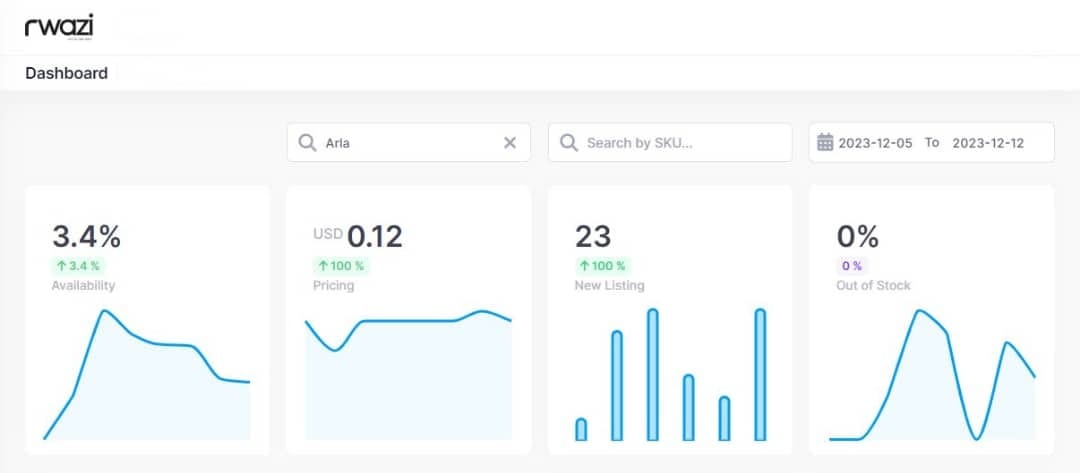
Welcome to another global intelligence briefing of Market Mosaic by Rwazi. We are excited you have continued reading our cutting-edge market insights and international economic trends. 📈 In case you haven’t yet, you can still fill out our survey to make our newsletter more valuable to you.
In this week's edition, we will dive into how big data analytics is disrupting oil forecasting and upstream operations on a global scale. From using machine learning to deliver higher fidelity price predictions to leveraging IoT sensors for optimizing asset productivity, we unpack big data's rapidly expanding role. As data becomes the new feedstock, we also assess the strategic shift underway and implications for the industry's future.
Let's dive into these insights together!
— Insights Team, Rwazi
Our Edition this week:
DATA SPOTLIGHT
Big data upending traditional oil forecasting models

For decades, estimating future oil prices relied heavily on historical data, market supply/demand reports, and human intuition. However, the rise of big data analytics is injecting unprecedented predictive capabilities by synthesizing a vast array of dynamic global signals.
Our analysis found that hedge funds and energy traders are increasingly turning to advanced machine learning models that ingest and correlate signals spanning economics, geopolitics, climate patterns, industrial activity, consumer behaviour shifts and more.
Quantitative models have demonstrated up to 27% higher accuracy in predicting short-term price moves over the past two years according to benchmarks by finding exploitable relationships that traditional forecasts miss.
For long-term forecasting, leveraging distributed cloud infrastructure can allow analysts to scenario-plan supply or demand shocks by incorporating disparate significant data streams like well permitting, rig counts, pipeline flow rates and capex cycle sensitivity.
Key Insight: Big data empowers oil and gas companies to finally escape the cyclical boom and bust by optimizing production and investment decisions based on higher fidelity price forecasting.
THE PULSE
Featured Chart: Historical and projected global oil prices since 2020

Source: ARIMA Forecast — Oil Prices [2020–2024] • Data analysis: Rwazi
SECTOR SCAN
National oil companies double down on data

While international oil majors have led early digital transformation efforts, national oil companies (NOCs) are prioritizing significant data initiatives as a competitive necessity:
They are now deploying billions of sensors across upstream, midstream and downstream assets to generate real-time performance data. Machine learning models ingest this output to optimize refinery operations, gasoline production, preventative maintenance and more.
Also, companies are centralizing all drilling, reservoir, and asset data into a unified data lake accessible to engineers enterprise-wide. This fuels advanced analytics for production optimization, supply chain planning and enhanced oil recovery strategies.
Key Insight: However, these companies must be pragmatic in bridging skill gaps, updating IT systems and cultivating data-driven cultures schooled in operational statistics and domain savviness.
OUR COMPETITIVE WATCH
Pioneering data-driven upstream asset management

Beyond forecasting, pioneering upstream operators are embracing big data analytics and industrial IoT sensing to improve asset productivity and extend asset lifecycle.
Majors like Shell have deployed thousands of sensors across upstream facilities to capture granular performance data on flow rates, pressures, equipment condition and integrity. Advanced predictive analytics models built atop this data visualize detailed digital twins of sound systems and surface assets.
These insights into real-time production constraints, bottlenecks and failure risk drivers enable automated condition-based monitoring and predictive maintenance. Interventions can be carefully planned, reducing operational expenditure and Health, Safety, and Environment (HSE) exposure versus reactive practices.
Long-term, AI/ML-powered autonomous monitoring could dynamically optimize asset and reservoir management for maximum productivity while enabling remote operations - disrupting decades-old paradigms.
Key Insight: Big data's role in lifting the fog for upstream producers who have long operated on lagging indicators is only just beginning.
WHAT’S HAPPENING AT RWAZI?
Become a contributor: Share your expertise on Market Mosaic
At Rwazi, we believe in bringing together diverse expertise to deliver insightful market intelligence. We are seeking industry leaders, experts, academics, analysts, and innovative thinkers to contribute articles, analysis, commentary, and data-driven insights through our newsletter, Market Mosaic.
By becoming a contributor, you will share your unique perspectives with our engaged audience of industry leaders, establish thought leadership, access Rwazi's data, and collaborate with our analysts. Are you interested? Kindly fill out the interest form here.

Thank you for reading and joining us on Market Mosaic this week. We hope this edition provides valuable, actionable insights for deciding with data. 📊
You can read the more extended version of this newsletter edition with detailed insights here.
If you missed the insights in our previous editions, you can catch up on them here on our newsletter blog.
What topics would you like to see covered in our newsletter?
- Sustainability trends
- Geopolitical risks and their impact on markets
- Regulatory changes affecting specific industries
- Future-of-work trends
- Consumer psychology and decision-making
- Fintech, cryptocurrency, regulations, future of banking
- E-commerce trends, supply chain optimization
- Artificial intelligence, cybersecurity, blockchain
- Telemedicine, healthcare access, pharmaceutical trends
- Electric vehicles, autonomous vehicles, future of mobility
